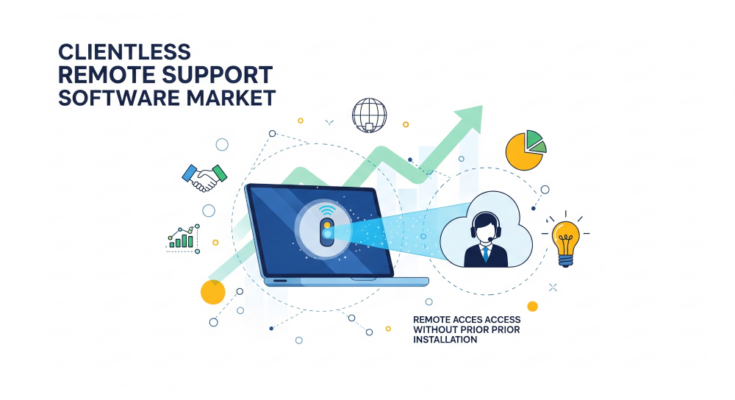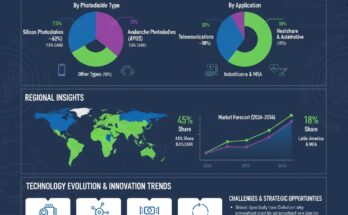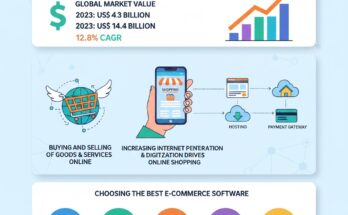As organizations increasingly adopt digital operations and remote work environments, clientless remote support software is becoming a critical tool for IT management and customer assistance. This software enables IT teams and support personnel to troubleshoot, monitor, and resolve technical issues without requiring end-users to install dedicated client applications, enhancing both efficiency and user convenience.
The clientless remote support software market is growing rapidly due to the surge in remote working, the need for seamless IT support, and the increasing complexity of enterprise IT infrastructures. These solutions simplify IT operations, reduce downtime, and provide organizations with the ability to address technical challenges swiftly and securely.
Market Overview
Clientless remote support software is designed to facilitate remote troubleshooting and support without requiring any installation on the end-user device. Typically, these solutions operate via web browsers or cloud-based platforms, allowing IT technicians to access desktops, servers, or mobile devices to diagnose and fix issues in real-time.
Key components of clientless remote support software include:
- Remote access tools: Enable secure connection to user devices through web browsers.
- Session management platforms: Manage multiple support sessions efficiently.
- Security protocols: Ensure encrypted communication and controlled access.
- Integration capabilities: Work with IT service management platforms, help desk tools, and enterprise applications.
The advantages of clientless remote support include reduced setup times, enhanced security by limiting software installations, cost savings, and improved customer satisfaction. Organizations benefit from faster issue resolution, minimal disruption, and centralized support management.
Regional Insights
North America
North America remains at the forefront of clientless remote support software adoption due to a mature IT infrastructure and high demand for efficient enterprise support solutions. Businesses across various sectors, including finance, healthcare, and technology, are leveraging these solutions to manage large-scale IT operations and reduce service downtime.
Europe
Europe shows steady growth driven by stringent regulatory compliance requirements and the increasing shift toward remote and hybrid work environments. Enterprises in the region prioritize secure remote support solutions that comply with data protection laws while ensuring operational efficiency.
Asia-Pacific
Asia-Pacific is emerging as a high-growth market for clientless remote support software, fueled by rapid digitalization, growing IT service outsourcing, and expanding SME sectors. Organizations in this region are adopting these solutions to streamline IT operations and provide faster technical support across geographically dispersed locations.
Other Regions
Latin America and the Middle East & Africa are witnessing gradual adoption of clientless remote support software. The demand is primarily driven by the growing need for remote IT assistance, cost-effective support solutions, and the expansion of global business operations requiring centralized IT management.
Key Trends & Forecast
Cloud-Based Remote Support Solutions
The migration of IT services to cloud platforms is significantly influencing the market. Cloud-based clientless remote support solutions offer scalability, flexibility, and reduced infrastructure costs. They enable support teams to access multiple endpoints without the need for physical installations, improving overall operational efficiency.
Mobile Device Support
With the increasing use of mobile devices in professional settings, clientless remote support software is evolving to support mobile platforms. Technicians can remotely troubleshoot smartphones, tablets, and other devices, providing comprehensive support beyond traditional desktops and laptops.
Enhanced Security Features
Security remains a top priority in remote support operations. Advanced encryption, multi-factor authentication, session logging, and role-based access control are being integrated into clientless remote support solutions to protect sensitive data and maintain compliance with organizational and regulatory standards.
Artificial Intelligence and Automation
AI-driven functionalities such as automated troubleshooting, predictive maintenance, and intelligent routing of support tickets are transforming clientless remote support. These innovations enhance the speed and accuracy of issue resolution, reduce human intervention, and improve overall support experience.
Integration with IT Service Management
Integration with IT service management platforms is becoming increasingly common. Clientless remote support software can now work seamlessly with help desks, ticketing systems, and asset management tools, allowing IT teams to provide proactive and efficient support.
Rise of Remote Work and Hybrid Environments
The global shift toward remote and hybrid work has accelerated the adoption of clientless remote support solutions. Businesses require tools that enable IT teams to assist employees wherever they are, without compromising security or productivity.
Applications & End-Use Outlook
IT and Managed Service Providers
Managed service providers and IT departments rely heavily on clientless remote support software to handle large client bases efficiently. These solutions allow technicians to troubleshoot issues remotely, reducing response time and improving service levels.
Healthcare Sector
In healthcare, clientless remote support software ensures uninterrupted access to medical applications and patient data. IT teams can provide secure support to hospital staff and clinicians, maintaining compliance with privacy regulations and safeguarding critical operations.
Education and E-Learning
Educational institutions use clientless remote support to provide technical assistance to students, faculty, and staff. This software helps maintain seamless access to e-learning platforms, online resources, and administrative tools, particularly in remote learning environments.
Finance and Banking
Financial institutions adopt clientless remote support software to manage IT infrastructures across multiple branches. These solutions enable secure and efficient resolution of technical issues, ensuring business continuity and protecting sensitive financial data.
SMEs and Large Enterprises
Both small-to-medium enterprises and large organizations are increasingly leveraging clientless remote support solutions to reduce IT costs, minimize downtime, and improve employee productivity. Centralized support capabilities allow businesses to handle complex IT landscapes efficiently.
Challenges in the Market
Despite its advantages, the clientless remote support software market faces certain challenges:
- Security Concerns: While clientless solutions reduce installation requirements, maintaining robust security across remote sessions is crucial to prevent unauthorized access.
- Connectivity Dependence: These solutions require reliable internet connections, and poor connectivity can hinder effective support.
- Integration Complexity: Aligning clientless remote support software with existing IT infrastructure and service management systems may pose challenges.
- User Adoption: Ensuring employees and end-users are comfortable with remote support practices is essential for optimal deployment.
Future Outlook
The clientless remote support software market is poised for continued growth as organizations increasingly embrace digital transformation and hybrid work models. Future developments are likely to focus on enhanced automation, AI-driven insights, advanced security protocols, and broader mobile device support.
Emerging technologies, such as augmented reality (AR) and virtual reality (VR) for remote troubleshooting, may further revolutionize the market, providing immersive support experiences for complex technical issues. Additionally, the integration of analytics and reporting features will allow organizations to monitor support performance, optimize processes, and improve overall service delivery.
With remote work becoming a permanent fixture in many industries, clientless remote support software is expected to remain a vital tool for IT departments, managed service providers, and organizations aiming to maintain operational efficiency and customer satisfaction.
Conclusion
Clientless remote support software is transforming IT assistance by providing secure, efficient, and convenient solutions for troubleshooting and support. The growing demand for remote work, advanced security measures, cloud-based platforms, and AI-driven functionalities is driving market adoption across various sectors, including healthcare, finance, education, and enterprise IT.
For organizations, investing in robust clientless remote support solutions is essential for maintaining productivity, minimizing downtime, and ensuring seamless access to critical IT systems. As the market continues to evolve, businesses that embrace these technologies will be better positioned to navigate the challenges of digital transformation and deliver superior technical support experiences.



